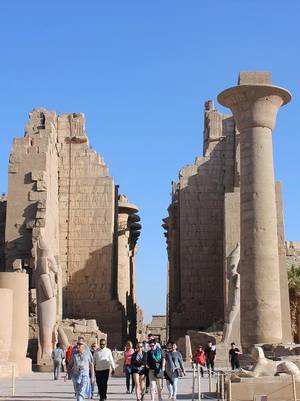With its magnificent temples and pharaonic tombs, Luxor, once known as Thebes, is where ancient Egypt rests in all its glory, discovers Fabiola Jacob.
Temple Round at Twilight
The Egyptians believed that the soul journeyed with the sun into afterlife, and so they built their temples and palaces on the east and elaborate tombs on the west bank of the River Nile. The sprawling Karnak Temple Complex is 250 acres of soaring columns, obelisks and statues. Built over a period of 2,000 years, pharaohs like Ramesses II, Queen Hatshepsut, Ahmose I and Amenhotep III have left their mark here. Everything here is super-sized, especially the Great Hypostyle Hall, with magnificent pillars shaped like papyrus stalks. Just a short drive down south, is the Luxor temple, built around 1400 BC, and dedicated to Amun Ra. The pharaohs were crowned here. Flanked by colossal statues of Ramesses II with a rather diminutive Queen Nefertari, the Luxor temple had two 75-foot-high obelisks (one of which is now at the Place de la Concorde in Paris) and impressive courts and colonnades. The avenue of the sphinxes (a 2.7-kilometre pathway to the Karnak temple) looks magical during twilight, as Luxor temple and the open-air museum are beautifully lit up at night, and kept open till 9 pm.
Valley of the Kings
Luxor’s biggest attraction — the Valley of the Kings — is more spectacular than the pyramids of Giza. The pharaohs built massive crypts in the barren hills west of Luxor during the New Kingdom (1539-1075 B.C.), as a royal resting place for pharaohs such as Tutankhamun, Seti I, and Ramesses II, as well as queens, high priests, and other elite of the 18th, 19th and 20th dynasties. Out of the 60 excavated royal tombs here, only three are opened for tourists each day. Yellow tuf-tufs (electrical train) wind their way through the low hills, ferrying visitors to the tombs. The tomb of Tutankhamun — the boy-king who died in 1327 BC at the age of 17 and was laid to rest in a golden sarcophagus, along with his chariots, throne, statues, toys and a fleet of miniature ships to aid his journey to the netherworld — is the main attraction. It was discovered 3,000 years later in 1922 by the British Egyptologist Howard Carter. The mummy of Tutankhamun rests in a climate-controlled environment here, while the golden mask, jewellery and the sarcophagus are at the National Museum in Cairo.
Queen Hatshepsut’s Temple
One of the most beautiful of the royal mortuary temples, the temple of Queen Hatshepsut — with three colonnaded terraces and two majestic ramps, set against the dramatic cliffs of Deir el-Bahari — is a sight to behold even from a distance. As stepmother and regent for the adolescent Thutmose III, Queen Hatshepsut managed to retain the throne by posing like a male pharaoh with royal headdress, kilt and false beard — as seen in the wall paintings here. Her successor and step-son Thutmose III’s attempts to wipe out her legacy are also evident.
On the way out from the Valley of the Kings, just a short distance from here, is the house of Howard Carter, the British Archaeologist and Egyptologist who discovered the tomb of Tutankhamun. It’s a museum now, with all the furnishing used by Carter and Lord Carnarvon his benefactor, left intact. This city sure takes you back in time. It makes you feel like you just stepped out of a time machine into another era. It also still is the hotbed of archaeological discoveries, regularly springing surprises from an unsuspecting world.








